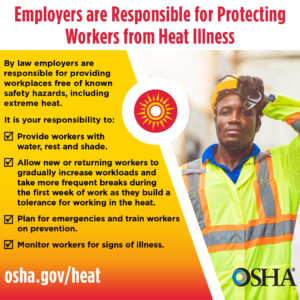News Flash!!! It’s summer time in the Southeast and I’m pretty sure you don’t need me to tell you it is hot and humid. The last few days most areas of the southeast have been under heat advisories. The summer is just beginning and employers should be considering and implementing methods and procedures to protect workers from the dangers of heat stress and heat related illnesses. Employers have always been aware of the dangers of heat in the workplace and in turn have made adjustments to address the hazards facing employees working indoors/outdoors in hot environments. This may be providing water, shade, frequent breaks, early starts times, etc. all which help to address the ability of employees to avoid the dangers of heat related illnesses.
OSHA has recently enacted a national emphasis program to address heat stress and heat related illness in indoor and outdoor workplaces. With this program, OSHA has released several fact sheets and guidelines to help employers address the hazards of heat related illness and increase awareness with employees.
What Factors May Contribute to Heat Illness?
- High temperature and humidity
- Low fluid consumption
- Direct sun exposure or extreme heat
- Limited air movement
- Physical exertion
- Bulky protective clothing
What is Heat Illness?
Heat Stroke: Is the most serious and occurs when the body can no longer regulate temperature and body temperature rises to levels greater than 104°F. This is a medical emergency that may result in death. The symptoms are confusion, loss of consciousness, seizures, and lack of the ability to sweat. Medical help must be called while attempting to cool worker down.
Heat Exhaustion: Is the next most serious and results in headache, nausea, dizziness, weakness, irritability, confusion, thirst, heavy sweating, and body temperature over 104°F. Workers with heat exhaustion should be moved to cooler area and given liquids to drink. The body can be cooled with cold compresses. Workers with signs of heat exhaustion should be taken to a health clinic or ER for treatment. Heat exhaustion can lead to heat stroke if not treated.
Heat Cramps: Are muscle pains caused by the loss of body salts and fluid due to sweating. Workers must replace fluid loss by drinking water or electrolyte replacement liquids .
Heat Rash: is the most common problem with hot work environments and is caused by sweating. It appears as red cluster of pimples on the neck, upper chest, groin, or elbow creases. The best treatment is to provide a cooler, less humid work environment.
One thing to remember with each of these types of heat illness, is that if not observed and treated early, a lesser illness could become a more serious illness. Therefore monitoring for and understanding symptoms is very important in protecting workers from heat related illness.
Prevention Made Simple
- Designate a person to oversee the heat stress program. This person must be trained in the hazards, physiological responses to heat, and controls. This person will oversee and monitor the program.
- Hazard identification involves recognizing heat hazards and the risk to workers due to high temperature, humidity, sun exposure, etc.
- Water-Rest-Shade. Water (cool/cold) is made available. Workers ae encouraged to drink water in small amounts frequently. Fully shaded or air-conditioned areas are available for rest and cooling down.
- Acclimatization is when workers are given time to build tolerance to working in the heat. Workload and exposure are gradually increased while taking frequent water and rest breaks. Acclimatization may take up to 14 days or longer and depends on the individual and the work environment.
- Modified work schedules may reduce worker exposure to heat. Increasing work/rest cycles, starting work earlier, rescheduling physically demanding work, and stopping work are all methods to modify work schedules to limit or prevent exposure of workers to high heat hazards. Consider coming in VERY early and knocking off before it gets too hot.
- Training provided in a language and manner workers understand, including information on health effects, symptoms, and how to prevent and response the heat illness.
- Monitoring for heat illness symptoms and establishing a system to report potential issues. Using the buddy system will assist supervisors and workers to monitor and watch for signs of heat illness.
- Emergency planning and response plans must be in place. What to do if heat illness symptoms occur. Who to call and how to provide emergency care until help arrives.
- Use a Buddy System. Have someone watch his or her buddy for the effects of heat stress/illness. Folks are likely to ignore their own symptoms but listen to a co-worker.
It is important for employers to monitor and be aware of heat related illness in the workplace. Unfortunately we work in a hot humid area of the country and these heat related issues may arise at some point. These topics have been discussed in the past and many already have methods used to address some of the hazards and issues presented above. With the introduction of the OSHA National Emphasis Program Related to Heat Illness Prevention, this presents a great opportunity to use the guidelines and information provided by OSHA to reevaluate and formalize and Heat Stress and Illness Prevention Program at your gin.
Additional Links and Information:
OSHA Fact Sheet:
OSHA Heat Illness Prevention Campaign:
OSHA Working in outdoor and indoor heat Environments:

